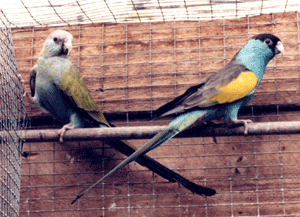 by Jim Hayward
by Jim Hayward
ORIGINAL HOMELAND:
The north east sector of Northern Territory, Australia.
NATURAL HABITAT:
Dry wooded grassland, with terrestrial termite mounds.
STATUS IN THE WILD:
In decline; on CITES schedule 1 of endangered parrots.
STATUS IN AVICULTURE:
Well established.
LEVEL OF KEEPER'S EXPERIENCE:
Knowledgeable aviculturists, well practiced in breeding the common Psephotus and/or Neophema parrakeets. HARDINESS: Latter day strains are more tolerant of winter conditions, previously these birds would be kept in enclosed aviaries during our autumn and winter and allowed out in spring and summer.
TYPE OF ACCOMMODATION:
Access to flights of around 10ft in length, these being attached to birdroom shelters which are large enough in which a breeding pair could be confined when the weather is obviously affecting them, or during the nesting cycle - if need be. Wooden frame and 19g wire mesh is sufficient.
TYPE OF DIET:
Small seeds are preferred (canary mixture, millet mixture, millet spray) with only a small amount of sunflower and safflower. Seeding grasses, seeding chickweed and germinated seed is most important during the breeding season; soft food such as canary egg food and bread and milk when nesting.
SEXING:
Cocks and hens are very different in colour, the obvious differences being the hen's lack of the cock's black mask and crown, golden yellow wing patch, dark back and flights, and brilliant deep turquoise body and face. Immatures carry the hen's subdued colours.
SEXUAL MATURITY:
Year old birds will attempt to breed.
NESTING SEASON IN BRITAIN:
Usually from late summer through autumn, though some breeders have reported spring breedings.
TYPE OF NEST:
It is usual to provide a plywood nest-box (about 5 1/2" square inside by 15" deep) which can be kept at a pleasantly warm temperature with either a heating pad in the base, or a light bulb placed by the side of the nest; in the early days hens could not be depended upon to keep the nestlings warm, but indications in recent years show that more hens are acquiring the instinct of brooding their young until they are almost feathered.
USUAL NUMBER OF EGGS:
Four to five.
INCUBATION PERIOD:
21 days.
USUAL NUMBER OF YOUNG:
Three to four.
FLEDGING AGE:
About five weeks.
USUAL NUMBER OF CLUTCHES:
Can be double brooded.
NESTING HABITS:
In the wild they burrow a tunnel and nest chamber in terrestrial termite nests.
SPECIAL CONSIDERATIONS:
Watch for over eager cocks driving their hens until they retaliate, a belligerent hen will turn a skirmish into a battle.
NOISE FACTOR:
They have pleasant quiet voices which could give no offence.
AVAILABILITY:
Always in demand, sometimes advertised but wise to reserve birds from a breeder.
COLOUR VARIETIES:
'Yellow' examples are said to exist, probably a Dilute variety.
